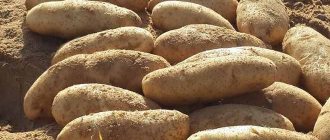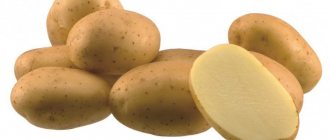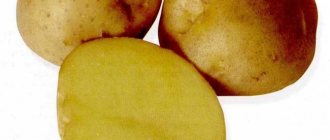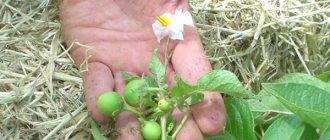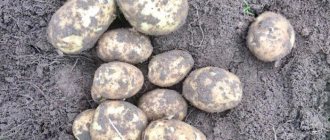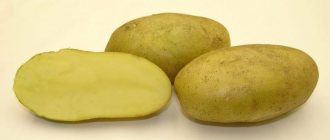The ultra-early German potato variety Jewel is suitable for cultivation in all regions of the country. In the southern regions, if desired, you can harvest twice. Compact low-growing bushes take up little space, ensuring economical use of the site. The culture has stable immunity to most diseases and is highly productive.
In the article we will talk about the rules of growing potatoes, methods of preventing fungal infections, combating wireworm larvae, the advantages and disadvantages of the variety.
Description of the potato variety Jewel
Potatoes Jewel (Yuvel) are a German super-early variety, characterized by high yield and good taste. Developed by specialists from Bavaria-Saat Vertriebs GmbH. It has not been tested in Russia, so it is not included in the register of breeding achievements. However, some summer residents have already tried to grow crops in different regions:
- middle lane;
- Northwest;
- southern regions.
According to reviews, Jewel potatoes take root well in different climatic conditions of Russia. Main characteristics of the variety:
- table (mass fraction of starch 10-15%);
- early ripening (technical ripeness after 50 days, highest yield after 70 days);
- medium height (50-60 cm).
Jewel potato bushes are somewhat prone to bending; they are moderately spreading and densely leafy. The leaves are deep green in color and have a typical shape and size. The corollas are large, light purple in color, and the inflorescences are compact.
The tubers are elongated oval in shape, with yellow skin and pulp. They are quite large in size - 5-8 cm or more in length, weight 80-150 g. They are very attractive in appearance: the surface is even, smooth, with a pleasant gloss, the eyes are invisible.
The pulp is practically not overcooked and holds its shape well. The taste is rich, delicate, not watery. At the same time, Jewel potatoes do not darken when cut even after heat treatment or freezing.
Potato Jewell produces large, marketable root crops
Advantages and disadvantages
Among the main advantages of the variety:
- excellent taste;
- high productivity;
- very early maturation;
- the tubers are smooth, oval, ideal for sale;
- universal potatoes, suitable for frying or boiling;
- tubers are well stored;
- drought resistance;
- the variety tolerates heat and short-term frosts;
- resistance to major diseases.
Disadvantages include sensitivity to watering . With a constant lack of moisture, the tubers become smaller and the number of ovaries under the bush decreases.
During frequent rains, the potatoes turn out larger, but their taste becomes watery.
Below in the table you can see the comparative characteristics of the marketable weight of tubers and their keeping quality for other very early varieties:
| Variety name | Weight of marketable tubers (grams) | Keeping quality |
| Farmer | 90-110 | 95% |
| Meteor | 100-150 | 95% |
| Minerva | 120-245 | 94% |
| Kiranda | 92-175 | 95% |
| Karatop | 60-100 | 97% |
| Veneta | 67-95 | 87% |
| Zhukovsky early | 100-120 | 92-96% |
| Riviera | 100-180 | 94% |
Characteristics of the potato variety Jewel
The Jewel potato variety is unpretentious and tolerates short-term drought and even light frosts. However, it is better to plant tubers in mid-May to avoid too sharp a drop in air temperature in the squat layer. The shelf life index is quite high - up to 94%. Root crops can be transported over long distances. The scope is universal: for cooking, frying, stewing, fries and chips. Jewel potatoes are well suited for soups, salads and main courses.
Productivity
Jewel potatoes ripen very early - the first digging can be done already 1.4 months after germination, that is, in early July. On average, each bush produces 10-15 large tubers, maximum 20. Yield indicators are very high:
- 1.2-1.8 kg from 1 bush;
- 4.5-6.5 kg per 1 m2;
- 450-650 kg per 1 hundred square meters.
There is evidence of record yields of up to 700 kg per hundred square meters. Similar indicators can be achieved when growing crops in the climatic conditions of the middle zone and the Black Earth Region, in fertile and light soils. To make the tubers as large as possible, you should follow the basic growing rules:
- watering in hot weather;
- hilling and fertilizing 2-3 times per season;
- regular weeding and loosening;
- prevention of late blight and other diseases.
Advantages and disadvantages
Jewel potatoes are widespread in Russia due to their very pleasant taste and really high yields. This is an undemanding crop that can be grown in the climatic conditions of most regions of the country.
Potato Jewel shows yield records of up to 600-700 kg per hundred square meters
pros
- very high yield;
- early ripening;
- good, pleasant taste;
- drought resistance;
- immunity to late blight on tubers and other diseases;
- low maintenance requirements;
- good keeping quality and transportability;
- attractive appearance.
Minuses
- weakly resistant to late blight on tops;
- yield depends on weather conditions;
- Lack of hydration affects the taste.
Farmer reviews
Reviews about the Juwel variety are mostly positive. The crop attracts the attention of farmers due to its early ripening, high productivity and resistance to most diseases.
Lyudmila, Cheremisinovo : “I’ve been growing potatoes for three years in a row. The bushes bloom in a beautiful purple color. I plant early and harvest twice - in June and September. This is an excellent early variety that is not afraid of drought, the Colorado potato beetle and late blight. Young potatoes with dill and butter are especially tasty.”
Larisa, Kantemirovka : “I grow Jewel for my own needs in order to obtain early potatoes. I start planting in April, by which time the soil in our region has time to warm up a little. I do the digging in mid-June. Not suitable for long-term storage. I water the bushes moderately so that the tubers are not too watery. I feed with manure before planting, and then once with superphosphate.”
Andrey, Salsk: “I first tried to plant this variety the year before last. I liked the result, so I decided to start growing potatoes for sale. The taste is not bad, it is important not to overwater the bushes, otherwise the tubers will be watery and insipid. The early ripeness of the crop allows harvesting in June. The plant is unpretentious in care and responds well to mineral supplements.”
Landing rules
Jewel potatoes are grown on fertile, light soils with a slightly acidic or neutral reaction. The optimal type of soil is sandy loam. If the soil is clayey or heavy, it must be prepared by adding 500-700 g of sand or sawdust per square meter. Also, the soil should be fertilized with compost or humus (3-7 kg per 1 m2). All this work is carried out simultaneously with digging the day before in the fall. If the deadlines are missed, you can make it in early April.
Advice! To plant potatoes, you should choose well-lit, level and dry areas. They should not have strong slopes where moisture accumulates - otherwise the yield may sharply decrease.
A month before planting, Jewel potato tubers are sorted and laid out in the light in a cool room (temperature 13-16 degrees). They are periodically sprayed, and on the day of planting they are pickled in a 1% solution of potassium permanganate or using fungicides: “Fitosporin”, “Hom” and others. You can also treat it with growth stimulants - Epin, Zircon.
Sprouted Jewell potatoes are ready for planting
Jewel potatoes can withstand light frosts, so in the middle zone and especially in the southern regions, tubers can be planted at the end of April. In the North-West, the Urals and Siberia, the dates shift closer to mid-May. The main criterion is that the soil temperature must have time to warm up to 10 degrees or higher, which is easy to check by burying a thermometer to a depth of 10 cm and holding it there for 15 minutes.
The Jewell potato planting scheme is standard:
- Form several furrows at intervals of 70 cm. Orient in direction from north to south.
- Make holes 5-10 cm deep (the lighter the soil, the smaller).
- Place the tubers at a distance of 25-30 cm from each other.
- Dust with ash and cover with soil.
Potato agricultural technology
The technology for growing the Jewel variety is standard and involves germination of tubers, timely planting, loosening, weeding and the application of organic and mineral fertilizers.
Dates, scheme and rules of planting
Jewel potatoes feel great on any type of soil, provided that organic matter and minerals are added. 20-30 days before planting, the tubers are prepared for germination. Seed potatoes are removed from the cellar, sorted and disinfected in copper sulfate (1 matchbox of powder, 1 g of potassium permanganate/10 l of water) or Fitosporin.
Another way to process potatoes before sprouting:
- 40 g urea;
- 60 superphosphate;
- 10 g boric acid;
- 5 g copper sulfate;
- 1 g potassium permanganate;
- 10 liters of hot water (80°C).
The components are mixed in an enamel bowl and, after cooling, the tubers are soaked in the solution for 15-20 minutes. Then the material is laid out in one layer on a flat surface to dry.
Important ! The soil for planting is prepared in the fall: they dig up and plant wheat or mustard. After a month, they are mowed and buried in the ground. Green manure increases the nutritional value of the soil and prevents the growth of fungi and bacteria.
Holes with a depth of 20 cm are formed on the site with an interval of 25-30 cm. The distance between the rows is 50-70 cm. 150-20 g of wood ash are poured into each hole. Small tubers are buried whole in the ground, large ones are cut in half and the cut is sprinkled with ash.
Care
Rules for caring for plantings:
- Watering is carried out as the soil dries once a week. In hot weather, the frequency of watering is increased to 2-3 times.
- After moistening, the soil is loosened to prevent the formation of a dense crust and saturate the root system with air.
- The bushes are earthed up as soon as the height reaches 15 cm. Then the manipulation is repeated after flowering. This promotes the formation of more tubers. At the same time, weeds are being weeded.
- For feeding, manure and mineral fertilizers with potassium, phosphorus and magnesium are used. The first root portion is applied 30 days before planting (manure or chicken droppings), the second foliar portion is applied after flowering. To accelerate the formation of tubers, growth stimulants are used - “Epin”, “Gibbersib”.
Potato producer Jewel recommends applying nitrogen fertilizers in minimal quantities (up to 140 kg/ha). Excess nitrogen inhibits the development of tubers, impairs taste, and accelerates the growth of tops.
Potassium complexes are applied in the amount of 150-300 kg/ha, phosphorus fertilizers - 100 kg/ha. Magnesium fertilization is carried out in an amount of 60-80 kg/ha. The dosage is adjusted depending on the growing region and soil composition.
Organic fertilizer options:
- 500 g mullein, 20 urea/10 l warm water;
- 1 tbsp. l. dry chicken manure/10 liters of water.
Options for mineral supplements:
- Dissolve 15 g of potassium sulfate with the same amount of double superphosphate in 10 liters of water;
- 100 g superphosphate/10 l water (use for spraying);
- 50 g of fresh yeast, 50 g of sugar/10 l of water, leave for 2 hours and add water 1:5 (the solution contains magnesium, zinc, boron, iron);
- 200 g urea, 10 g boric acid/10 l (solution for spraying bushes).
The content of surfactants (surfactants) in ready-made fertilizers promotes the rapid penetration of minerals into the plant.
Nuances of cultivation and possible difficulties
Another method is used for planting potatoes - without digging the soil. The tubers are planted directly onto the turf and covered with a thick layer of mulch (hay, straw, sawdust, peat). This method is also called natural due to the fact that the tubers grow not on the root, but on stolons (a quickly dying side shoot with underdeveloped leaves, elongated internodes and axillary buds). No land is required for this. The main task is to provide the plant with nutritional components by introducing complex compounds.
Even beginners do not have any difficulties with growing the Jewel variety. Potatoes are planted even in insufficiently warmed soil. The culture withstands light frosts.
Important! When watering the bushes, keep in mind that excess moisture negatively affects the taste of potatoes. The fruits become watery and insipid. To control moisture, a drip irrigation system is installed on the site.
The crop grows on any soil, but to increase fertility, experienced farmers recommend using Agromax fertilizer. It contains humic acids, bioactive water and blood meal. All this contributes to the strengthening of plants, the growth of beneficial microorganisms in the soil, and the saturation of cells with nutrients.
Diseases and pests
Thanks to ultra-early ripening, potatoes have time to bloom and form tubers before the massive spread of late blight spores and Colorado potato beetle larvae that infect the crop in mid-summer.
To prevent diseases, tubers are treated with potassium permanganate, boric acid or Fitosporin before planting . The bushes are sprayed with a 1% solution of Bordeaux mixture or copper sulfate (20 g/10 l), with Silk and Krezacin preparations.
The culture has strong immunity to scab, cancer, tuber rot, and golden nematode.
The voracious wireworm larvae pose a danger to the future harvest.
Signs of damage:
- through holes in the fruit and dark depressions on the peel;
- wilting of bushes;
- detection of larvae when working in the garden.
Preventive measures:
- competent crop rotation;
- timely harvesting;
- reducing soil acidity;
- attracting click beetles, ground beetles, starlings, crows, blackbirds, doves, rooks, wagtails, and tits to the site;
- weeding.
Fighting methods:
- sprinkle the beds with ground eggshells;
- prepare a solution of 500 g of nettle tincture/10 liters of water and fill the holes before planting, then treat the beds 2-3 times for 7 days;
- add 30 g of ammonium nitrate per 1 m²;
- water the bushes with a weak solution of potassium permanganate at the root;
- treat the plantings with Decis, Actellik, and Barguzin.
Features of cultivation
The Jewel variety is unpretentious. However, to improve taste and get a good harvest, you must follow the basic growing rules:
- Regular watering in hot weather - at least once a week (a bucket for 2-3 bushes). If possible, it is better to use a drip irrigation system.
- Hilling - 2-3 times per season: after the tops reach 15 cm, then at intervals of two weeks.
- Fertilizing with complex mineral fertilizer or organic matter (infusion of manure) also 2-3 times per season (before hilling).
- Loosening is regular: twice a month, especially after watering and rain.
- Weeding by hand or with a hoe - as needed.
Diseases
Struggle
Diseases that can affect tubers:
- fungi - in conditions of thickened plantings, waterlogging of the soil, non-compliance with crop rotation, violation of planting technology;
- late blight - with dense crops, replanting in mid-summer.
The main pests of the Jewel variety:
- Colorado potato beetles;
- nutcrackers.
Important!
An effective method of pest control is manual collection from the beds. In critical cases - spraying with insecticides. Spraying plantings with Fitosporin during the growing season can help in the fight against fungal diseases.
Folk remedies for late blight include the following methods of control:
- Treatment with infusion of garlic and potassium permanganate. Grind 100 g of garlic, add water (1 glass), leave for 24 hours, mix with a solution of potassium permanganate (1 g of substance per 10 liters of water). Spraying is carried out every 2 weeks. 0.5 liters are consumed per bush.
- Spraying with sour milk whey diluted with water (ratio 1 to 1). The procedure has been carried out every 2 weeks since July.
- Processing with wood ash.
- Watering with yeast. 100 g of the substance are stirred in 10 liters of water. The product is used at the first signs of late blight disease.
Prevention
As a preventive measure against fungal infections, tubers are treated with a disinfectant solution of potassium permanganate or boron before planting and must be dried. Be sure to maintain an interval between crops when sowing to avoid overcrowding. Remove affected tubers from the area.
Crop rotation is taken into account. To protect potatoes from pests, before planting, areas are sown with phacelia, oilseed radish, and legumes.
Pests and diseases
Jewel potato has good immunity to canker, golden nematode and common scab, and average resistance to late blight on tubers. However, late blight on the tops is often observed, although thanks to the early stages the variety may have time to “escape” the infection. At the same time, in reviews, summer residents sometimes write that plants can suffer massively from both this disease and Alternaria.
Therefore, it is extremely important to carry out preventive measures - these are simple actions that will minimize the risk of diseases and pest invasions:
- Change the planting site every 3 years.
- Do not sow Jewel potatoes where other Solanaceae grew last season - tomatoes, eggplants, any varieties of potatoes, peppers.
- Treat the tubers before planting.
- Apply a single fungicide treatment after the tops grow to 15-20 cm.
- To combat insects, use folk remedies and insecticides.
Preventive measures will help protect Jewel potatoes from late blight and other dangerous diseases
There are a lot of preparations for the prevention of potato diseases - for example, among fungicides the following are particularly effective:
- "Home";
- "Prestige";
- "Quadris";
- "Fitosporin";
- copper sulfate;
- Bordeaux mixture.
To combat aphids, Colorado potato beetles, click beetles, mole crickets, wireworms and other pests, insecticides are used:
- "Biotlin";
- "Colorado";
- "Spark";
- "Decis";
- "Fitoverm";
- "Agravertine".
You can also prevent pest infestations using folk remedies. For example, in dry and windless weather, you should dust the bushes with ash. The plantings are mulched with straw, fresh sawdust is placed between the rows, and a weak tar solution is periodically poured. The bushes can be treated with a decoction of marigolds, an infusion of chili peppers, mustard, and garlic cloves. If possible, coriander, fragrant tobacco, calendula and other fragrant plants are planted near the Jewell potato field.
Advice! If possible, it is better to plant Jewel potato varieties and any other variety in fields where any root crops, winter grains, legumes or cucumbers previously grew.
Advantages and disadvantages
Disadvantages include sensitivity to watering. With a constant lack of moisture, the tubers become smaller and the number of ovaries under the bush decreases.
To appreciate all the benefits of ultra-early potatoes, “Juvel” is planted in the spring, without waiting for the soil to completely warm up. Tubers calmly tolerate weather changes without suffering from a possible drop in temperature. The ideal option is the end of April or the beginning of May, at this time the soil is saturated with moisture and the potatoes quickly begin to grow. In regions with cooler climates, the dates can be shifted by a week. Before planting, it is recommended to treat the tubers. During cultivation, you should adhere to a watering schedule. Constant drought will reduce the yield and the potatoes will become small. Constant flooding will increase the size of the root crops, but will significantly deteriorate their consumer qualities; the tubers will acquire a watery taste. A good solution is drip irrigation, which helps maintain an optimal level of moisture in the soil without stagnation. Timely hilling with the formation of high ridges above the bushes is very important. It is recommended to feed the bushes at least 2 times during the season, using mineral complexes based on potassium or organic fertilizers (diluted mullein, bird droppings). The variety is very responsive to fertilizing and is not prone to the accumulation of nitrates.
Harvesting and storage
Jewell potatoes can be harvested twice:
- 45 days after germination.
- 60-70 days after germination.
The last digging is carried out in mid-July, after which the second crop rotation can begin. In two weeks, it is advisable to mow the tops to a height of 10 cm so that the tubers gain mass. Jewell potatoes are traditionally harvested on a dry and warm day. The tubers are laid out on the ground to dry, then put into bags and stored in a dark room. The first two weeks maintain the temperature at 14-15 degrees, then in the range of 2-4 degrees, the humidity level is 70-80%.
Potatoes can be stored in bags or wooden boxes
Attention! It is better to consume the largest and smallest Jewel potato tubers first, and the remaining root vegetables can be sent for long-term storage.


